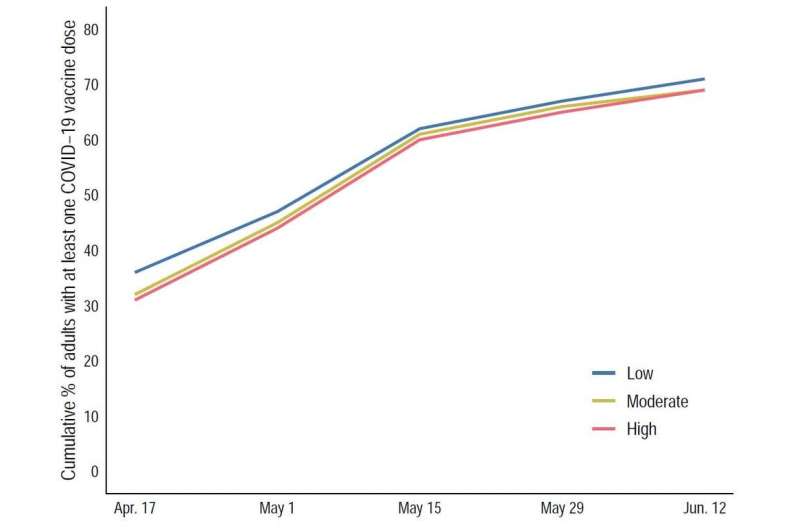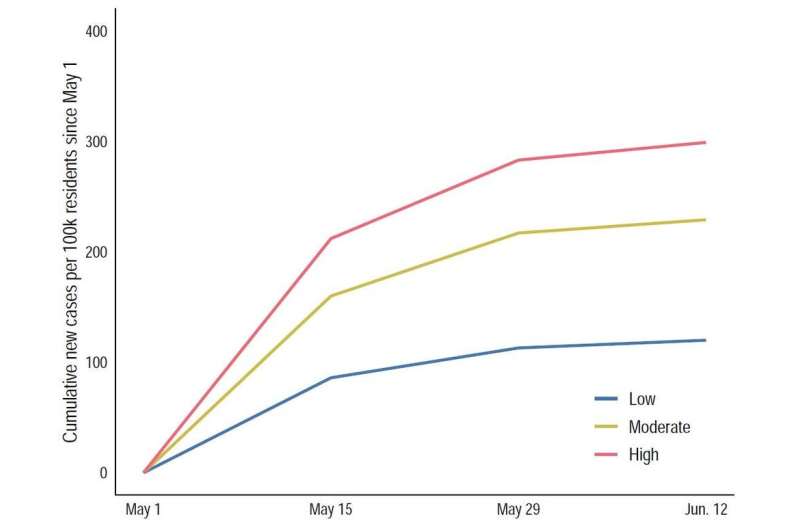Even with equal vaccination rates, COVID-19 hotspots still have higher infection rates

Research shows vaccines can turn the tide of the pandemic. The emergence of deadly variants, lower initial vaccine rates among vulnerable groups, and continued surges in COVID-19 cases in communities with low vaccination rates have kindled concerns about vaccine equity.
As COVID-19 hotspots emerged in cities like Toronto, there were efforts to increase vaccine availability and uptake in those neighborhoods. However, because neighborhoods have different levels of risk of exposure, equal vaccination rates may not result in similar COVID-19 infection rates. Our team looked at these inequalities in Toronto's neighborhoods.
In Toronto, vaccination rates were lower in racial minority and immigrant communities in early April 2021. These communities were also disproportionately affected by the pandemic. This means that vaccination rates were lower in communities with higher COVID-19 infections.
Since then, the supply of vaccines in Canada has increased dramatically. The share of Canadians who received at least one dose of a COVID-19 vaccine rose from less than 14 percent on April 1 to 69 percent on July 7.
The Ontario government also carried out policies aimed at a more equitable distribution of vaccines, including allocating half of all new doses to Ontario's COVID-19 hot spots for two weeks in early May.
A recent poll in the United States also showed that vaccine hesitancy has diminished the most among racial minorities, and there are only small differences in vaccine hesitancy by race. Similarly, vaccine hesitancy decreased significantly among racial minorities in Toronto.
These developments may have increased vaccination rates in at-risk neighborhoods and reduced disparities in vaccination rates across communities with varying COVID-19 risks. But was this the case? Did efforts aimed at more equitable distribution of the vaccine help reduce inequalities in COVID-19 rates across communities?
Our team addressed these questions by comparing the vaccination uptake of neighborhoods in Toronto with low, moderate and high COVID-19 levels between mid-April and mid-June 2021. Our research, which is currently undergoing peer review, also examined whether inequalities in COVID-19 rates diminished during this time.
Vaccination rates grew more equal over time
In April, neighborhoods with a higher COVID-19 risk had lower vaccination rates than those with a lower COVID-19 risk. The average difference in COVID-19 vaccination rates was 4.4 percentage points between neighborhoods with low and moderate COVID-19 risks, and 5.8 percentage points between neighborhoods with low and high COVID-19 risks.
Vaccination rates, however, grew faster in neighborhoods with higher COVID-19 risks. By June, the average difference in vaccination rates between neighborhoods with low and moderate COVID-19 risks was one percentage point. The corresponding difference between neighborhoods with low and high risks of COVID-19 was 1.7 percentage points.
These findings suggest that Ontario's policies aimed at improving vaccine equity have been effective at increasing vaccination rates in neighborhoods hit hard by the COVID-19 pandemic.

Persistent disparities in COVID-19 rates
COVID-19 infections spread more slowly in neighborhoods where vaccination rates increased quickly. Yet, COVID-19 infections continued to spread more in at-risk neighborhoods even though vaccine rates grew faster in these communities. For example, between April and June 2021, for every 100,000 residents, neighborhoods with a high COVID-19 risk had 421 more COVID-19 cases than low-risk neighborhoods.
The faster spread of COVID-19 in at-risk neighborhoods is largely attributable to the social, economic and demographic composition of these areas. Essential workers, some racial minority groups and immigrants continue to have greater exposure to the COVID-19 virus.
The overall implication is that vaccination rates in at-risk communities did not rise fast enough to counteract their higher risk of infection. This higher risk emerges from structural disadvantages that render residents of at-risk neighborhoods more vulnerable to COVID-19 infections. Our earlier research, which is also undergoing peer review, identified some of these factors as overcrowded housing and need to travel—often via public transit—for necessities like food and health care.
Our results also reveal that immigrant neighborhoods have been left behind in Toronto's vaccination roll-out. Not only did they have lower vaccine rates in April, but rates in these neighborhoods also increased at a much slower pace. Lower vaccination rates and greater exposure to the COVID-19 virus may be the reason why COVID-19 spread faster in immigrant neighborhoods.
Implications for the vaccination roll-out
In Toronto, the average vaccination rates across neighborhoods with varying COVID-19 risks are nearly equal. In the absence of herd immunity, having the same vaccination rate in populations with different degrees of exposure to the virus will not result in the same infection rate. Under such circumstances, COVID-19 will continue to spread faster in at-risk neighborhoods.
With the emergence of COVID-19 variants, whether or not Canada will ever achieve herd immunity is unclear. Therefore, reducing disparities in COVID-19 infections may require greater allocation of vaccine dosages and higher vaccination rates among groups at greater risk.
Greater efforts should also be made to understand and reduce the barriers to vaccine access among immigrant communities, including travel time and language barriers. Addressing these factors may hold the key for Toronto to reduce inequalities in COVID-19 rates.
Finally, vaccines should not be viewed as a silver bullet that can end the pandemic. Equitable distribution of vaccines should occur in tandem with other safety measures to slow the spread of COVID-19. Such multifaceted strategies are our best weapon against variants and our best chance at defeating the pandemic.
This article is republished from The Conversation under a Creative Commons license. Read the original article.![]()




















